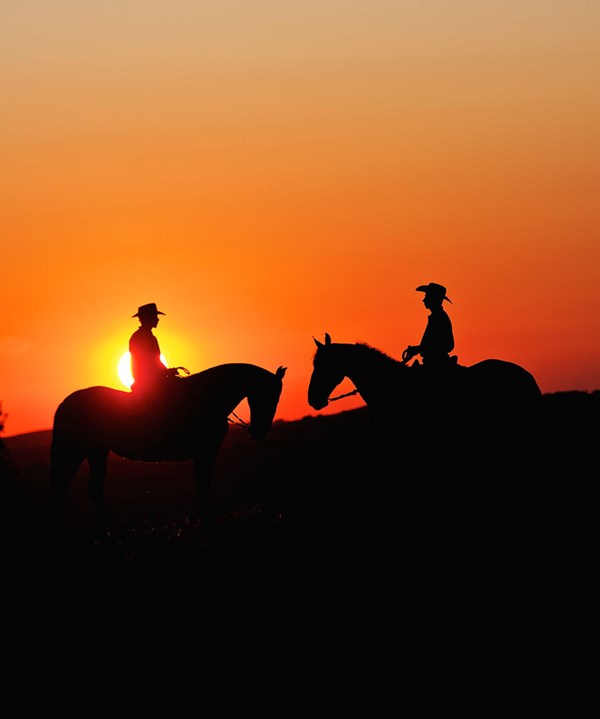
The most rewarding part of being a horse trainer has turned out to be something entirely unexpected through the years. More so than the ribbons won or milestones achieved, my most meaningful accomplishment has been collaborating with other trainers. As much as we might wish to, not a single one of us holds all the answers for every horse or training challenge. Occasionally this requires a swallowing of pride, but by teaming together we enhance each others’ skills, bolster individual strengths and fill in for
the others’ weaknesses.
Having colleagues requires active effort for most equine professionals, given that generally we do not work as part of teams or in office-like workplaces where colleagues are a consistent part of everyday life. Ours has become a world not only of toiling long hours alone in dusty arenas but also of branding our individual skills and promoting them through on-line platforms and horse television shows and huge clinics with stadium seating. While these things are, in fact, necessary for reaching clients and building income, they sometimes feel at odds with the satisfaction derived from finding common ground with fellow trainers rather than isolating individual differences for the sake of marketing. Knowledgeable minds working together always create better outcomes than one working alone.
When I moved from the east to west coast over a decade ago, as a strict dressage queen I found myself sharing barns with trainers from disciplines I had never encountered before: reining, gaited horses, halter showing and different breed competitions. For the first year, I kept my distance, mostly disinterested in their training and horses. In hindsight, I’m pretty sure I thought whatever they were doing was not very important because it wasn’t dressage.
That changed the day a new student trailered in for a lesson and after an hour of exhausting all my training tricks, we could not get her young gelding to settle down. The poor horse was nervous, jumpy and in no state to ride.
Seeing our situation, the Arabian trainer across the barn, who I spent the last year ignoring, walked over and offered his help. I agreed to give him 10 minutes with the horse. It turned out that he needed only a few more than that to morph the horse to a state of complete calmness.
After what appeared to be pretty basic groundwork and body movements, he walked the horse back to us completely relaxed and ready for our lesson. And he did so with no chip on his shoulder about it. He saw the situation as one in which his own individual strengths could help me and, perhaps in turn, someday I could help him solidify some dressage principles that he needed.
Since that spring day, Mark Schuerman and I have become dear friends and colleagues. He has helped me solve issues with horses that were impatient, herd-bound, spooky, afraid of clippers, balky about trailering and so on. I reciprocated with my dressage expertise and watched his riding change from him not being able to make a circle to winning national dressage titles at the U.S. Arabian National Sport Horse Championships. Mark and I have always respected each other’s separate strengths and honored our different approaches to training methods, which I consider a rare achievement in the sometimes opinionated and emotional world of training horses.
That first experience of reaching across the barn aisle for help from a cowboy encouraged me to continue seeking the unbounded strength of symbiotic professional partnerships. I now make a point of cultivating alliances with like-minded trainers—no matter what their discipline—wherever I am training. We all have gifts to offer each other. But we must first make the effort to cultivate trusted colleagues.
Of course, as with any collaboration, disagreements about specific training details sometimes arise, but through respectful treatment of these differences—and each other—we become more informed and clearer in our own beliefs. This, in turn, makes us better trainers and instructors for our students. It also creates a standing network of proven resources for training issues we might otherwise approach with mere guesswork.
To love horses means remaining willing to constantly improve one’s skills. As a trainer this can be a challenge, especially when students expect that any of us has all the answers. Fortunately, the gifted experts with whom I share this profession make this endeavor less an act requiring humility and more one that deserves celebration.
Jec Aristotle Ballou is a nationally recognized educator on equine conditioning and gymnastic development. She is the author of the books 101 Dressage Exercises for Horse and Rider and Equine Fitness. She has trained and competed in dressage through the FEI levels.She also trail rides long distance. She is the youngest rider to win the Vermont 100-Mile Competition. A student of the late Egon von Neindorff, she has also studied with Manolo Mendez (jecballou.com). Find her books at HorseBooksEtc.com.











